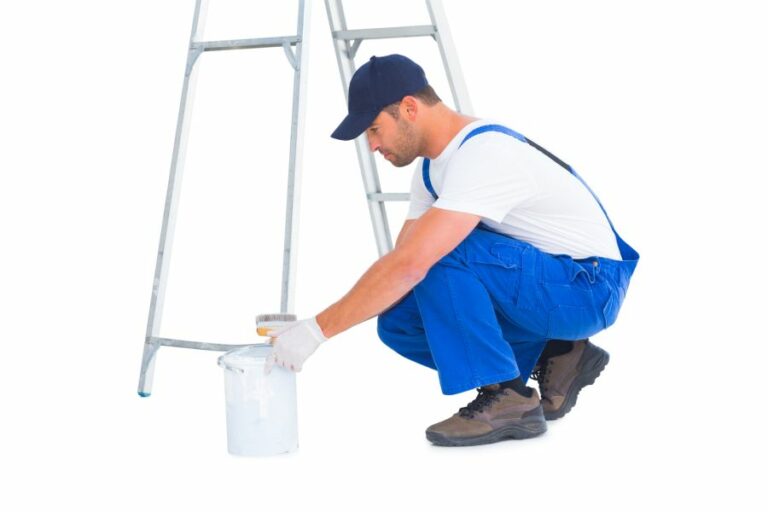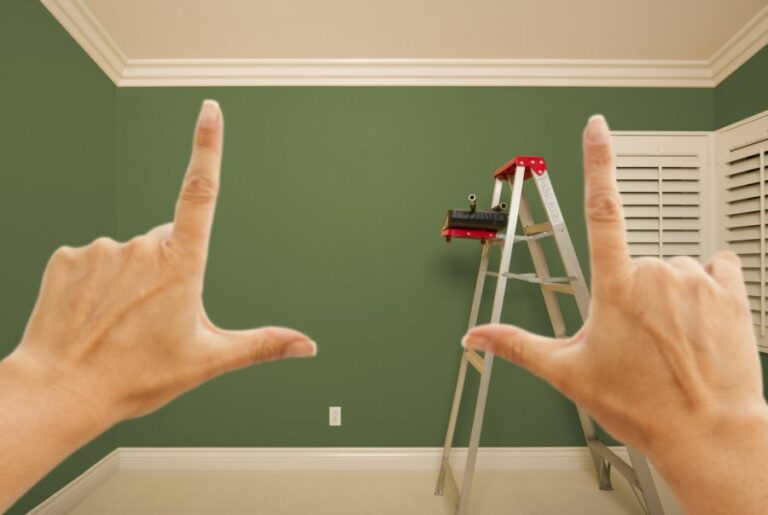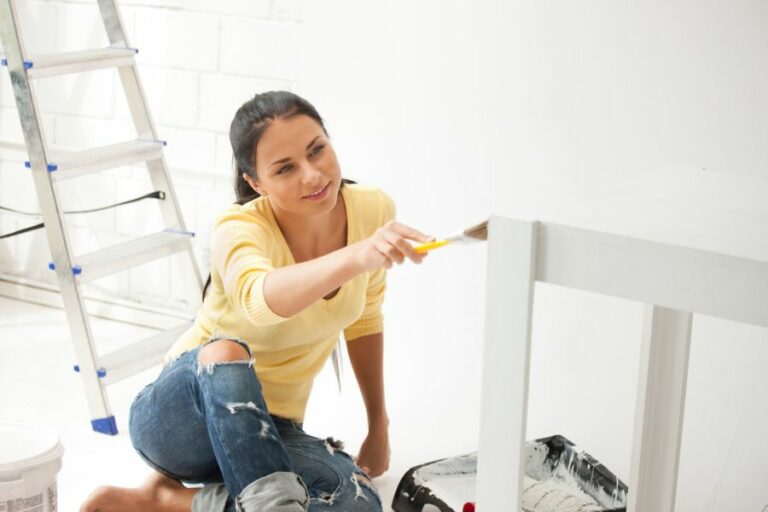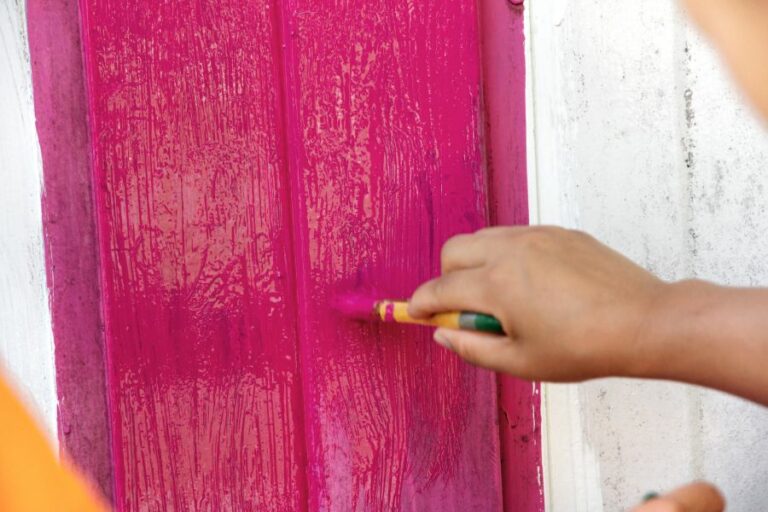Spray Paint Or Brush Paint Outdoor Furniture. What Pros Say
Deciding whether to use spray paint or brush paint when giving your outdoor furniture a fresh new look can be a bit of a dilemma. After all, you want to achieve a flawless finish that will not only enhance the appearance of your furniture but also provide long-lasting protection from the elements. Having tackled various painting projects ourselves, rest assured, I’ve got the knowledge and experience to guide you through this process.
Spray paint or brush paint outdoor furniture:
When choosing between spray paint and brush paint for outdoor furniture, consider the material, ease of application, and cost. Metal and plastic furniture are better suited for spray paint, while wooden furniture can be painted with either option. Spray paint provides a quicker, smoother finish, while brush paint offers more control for intricate details. Ensure the proper preparation and follow expert tips for the best results.

Unsure whether to choose spray paint or brush paint for your outdoor furniture? Don’t worry, I’ve got you covered! Read on to explore the benefits of each method and make an informed decision that suits your needs. Discover expert tips and tricks to elevate your furniture’s appearance in no time.
Contents
- 1 Choosing Between Spray Paint or Brush Paint for Outdoor Furniture
- 2 Which is more effective for furniture: spray painting or using a brush?
- 3 Is Spray Paint an Effective Solution for Outdoor Furniture?
- 4 Is it Possible to Apply Paint on Outdoor Furniture Using a Brush?
- 5 Is the Application of Exterior Paint through Spraying More Effective than Rolling Technique?
Choosing Between Spray Paint or Brush Paint for Outdoor Furniture
• Making the Right Choice: Factors to Consider
When it comes to painting outdoor furniture, you have two main options: spray paint or brush paint. The decision of which method to use depends on a few factors, including the specific types of paint, the material of the outdoor furniture, and your personal preferences.
– Material of the Furniture
The type of paint you choose should be compatible with the material of your furniture. For example, metal and plastic furniture are better suited for spray paint, while wooden furniture can be painted with either spray paint or brush paint. Let’s discuss each material in more detail:
1. Metal Furniture
Metal furniture often requires a different type of paint due to its non-porous surface. Spray paint is usually a better choice for metal furniture because it can easily cover the entire surface and get into crevices that are difficult to reach with a brush.
Moreover, some spray paints are formulated specifically for metal surfaces, such as Rust-Oleum or Krylon, and provide better adherence and protection.
2. Plastic Furniture
Plastic furniture is another good candidate for spray paint. Similar to metal, certain spray paints are formulated to bond well with plastic surfaces, ensuring durable results. Using a brush to paint plastic furniture can result in streaks and uneven coverage, which can decrease the overall aesthetic appeal.
3. Wooden Furniture
Wooden furniture can be painted using either spray paint or brush paint. However, the choice ultimately depends on the desired look and level of detail.
Brush painting allows for more control when painting intricate details, such as slats, spindles, and carvings. Spray paint is great for achieving an even, smooth finish on wooden furniture with less intricate details.
– Ease of Application
Another factor to consider is the ease of application. Some people find it easier and faster to use spray paint, while others prefer the control of using a brush.
Spray Paint Application
Spray paint allows for a quicker application process and a smooth, even finish without brush strokes. It is also easier to apply multiple thin coats, which results in a more durable and long-lasting finish.
However, spray painting requires proper air circulation, and it can be challenging to control overspray, especially on a windy day. The use of drop cloths and painter’s tape is essential to protect surrounding areas.
Brush Paint Application
Brush painting is an effective method when precision and control are necessary, such as when working on intricate details on wooden furniture. However, it can be more time-consuming, as you may need to take extra care to ensure even coverage and avoid drips or brush marks.
– Cost and Environmental Impact
The cost of spray paint can be higher than brush paint, especially if you need to purchase multiple cans to cover your furniture. Additionally, since spray paints are aerosol products, they contribute to air pollution and may not be the most environmentally friendly option.
Brush paint, on the other hand, tends to be more affordable and has a lower environmental impact.
• Expert Recommendations for Painting Outdoor Furniture
– Prepping the Furniture
Regardless of which method you choose, proper preparation of the furniture is essential for a lasting and professional-looking result. Ensure that the furniture is clean and dry before beginning, and sand or scrape any loose paint or rust.
If your furniture is made of metal or plastic, consider using a primer before painting. This can improve adhesion and provide a smoother finish. There are also specific primers available for metal or plastic surfaces that can enhance results.
– Spray Painting Tips
- Always read and follow the instructions on the spray paint can.
- Apply thin coats to avoid drips and runs.
- Hold the can approximately 10-12 inches away from the surface you are painting.
- Move the can in a continuous sweeping motion.
- Use proper ventilation and respiratory protection when spray painting.
– Brush Painting Tips
- Select a high-quality paintbrush with synthetic bristles for water-based paint or natural bristles for oil-based paint.
- Load the brush with paint and apply in smooth, even strokes.
- Paint in the direction of the wood grain on wooden furniture.
- Apply multiple thin coats, allowing each coat to dry as directed by the paint manufacturer.
• Conclusion
Choosing between spray paint and brush paint for your outdoor furniture depends on a variety of factors, such as the material of the furniture, ease of application, and cost.
By considering these factors, along with the expert tips and recommendations provided, you can achieve a professional and long-lasting paint job for your outdoor furniture.
Which is more effective for furniture: spray painting or using a brush?
When it comes to giving new life to old furniture, painting is one of the most popular and cost-effective methods. However, should you opt for spray painting or using a brush?
• Spray Painting Furniture
Spray painting involves using a can of aerosol paint or a paint sprayer to evenly apply paint on furniture surfaces. This method has gained popularity over the years due to several advantages it offers.
– Advantages of Spray Painting
- Uniform finish: Spray paint provides a smooth, even finish without any brush strokes, which makes it ideal for achieving a professional-looking result. This even finish is particularly important when working on projects with intricate details or surfaces that are difficult to reach with a brush.
- Efficiency: Spray painting is generally faster than using a brush, as the paint can be applied more quickly and evenly over large surfaces.
- Less Mess: Since there is no need for a paint tray or a brush to clean, spray paint tends to be less messy than the conventional brushing method.
– Disadvantages of Spray Painting
- Cost: Spray paint cans or purchasing a paint sprayer can be more expensive than traditional brush-on paint. Additionally, spray paint typically requires a primer and multiple coats, which can further increase the cost.
- Ventilation requirements: Spray painting releases paint particles into the air, making it necessary to work in a well-ventilated area. This may not always be possible, depending on the location of your painting project.
- Overspray: – It can be challenging to control the spray pattern, which may result in the paint landing on unintended surfaces. Protective covering materials and masking tape are essential to prevent overspray.
• Brush Painting Furniture
Brush painting involves using a paintbrush, roller, or sponge to manually apply paint onto the furniture’s surface. This method has been around for centuries and continues to be widely used due to several advantages.
– Advantages of Brush Painting
- Precision: Using a brush allows for more control over the paint application, making it easier to paint edges and corners accurately. This precision is ideal when working on projects that require intricate details or designs.
- Lower cost: Brush-on paint is generally cheaper than spray paint, making it a more economical option. Additionally, brushes and rollers can be washed and reused, further reducing costs.
- Less VOCs: Brush painting typically releases fewer volatile organic compounds (VOCs) into the air compared to spray painting. This makes brush painting a more eco-friendly option, especially when using low or zero-VOC paints.
– Disadvantages of Brush Painting
- Brush strokes: It can be challenging to achieve a completely smooth finish with brush painting, as brush strokes may be visible on the finished surface.
- Effort and time: Brush painting can be time-consuming and labor-intensive, particularly for large or intricate projects.
• Recommendations Based on Personal Experience
– When to Use Spray Paint
I recommend using spray paint for projects with intricate details or hard-to-reach surfaces where a brush would be less effective. Examples include wicker furniture, detailed carvings, or any time you’re looking for a perfectly smooth, professional finish.
Make sure to follow safety guidelines and work in a well-ventilated area when spray painting. The U.S. Environmental Protection Agency offers valuable safety tips for using aerosol paint products.
– When to Use Brush Paint
I recommend brush painting for projects requiring precision, such as painting edges and corners or applying designs. Brush painting is also a more economical option, so if you’re on a tight budget, consider using a high-quality paintbrush and roller to give your furniture a fresh coat of paint.
In conclusion, both spray painting and brush painting offer their unique advantages and disadvantages. Your decision will ultimately depend on the type of project, the desired finish, available resources, and personal preferences.
Be sure to weigh these factors before making a decision, and you’ll be on your way to a successful furniture painting project!
Is Spray Paint an Effective Solution for Outdoor Furniture?
Spray paint is often considered an effective and time-saving solution for revamping outdoor furniture. You may wonder, though, whether using spray paint is truly the best option for your outdoor furniture.
• Benefits of Using Spray Paint for Outdoor Furniture
– Quick and Even Application
Spray paint allows for a quicker and more even application compared to brush painting. Your outdoor furniture can be given a clean, unblemished look in a relatively short amount of time.
– Cost-Effective
Spray paint can be purchased at most hardware stores in a wide variety of colors and finishes. Typically, a can of spray paint will cost less than a container of outdoor paint.
This price difference, along with the reduced need for tools and materials like brushes, trays, and paint thinner, makes spray paint a more cost-effective option for updating outdoor furniture.
– No Visible Brush Strokes
Since spray paint is not applied using a brush or roller, it means that your outdoor furniture will be painted without any evident brush strokes. This feature results in a smooth, professional-looking finish.
– Wide Range of Colors and Finishes
Spray paint is available in various colors, finishes, and sheens. You can choose a color that matches your existing outdoor decor, or you can experiment with a new look. Finishes include satin, matte, glossy, and metallic options, giving you the flexibility to customize your furniture according to your desired style.
• Precautions when Using Spray Paint for Outdoor Furniture
– Proper Ventilation
Spray paint contains volatile organic compounds (VOCs) that can be harmful if inhaled. Make sure to use spray paint in a well-ventilated area, with appropriate respiratory protection, such as a paint respiratory mask.
– Protective Measures
Aside from respiratory protection, it is essential to protect your skin and eyes from spray paint. Wear safety glasses, gloves, and coveralls or old clothing to minimize exposure to the paint.
– Weather Considerations
When painting outdoor furniture, weather conditions are an essential factor to consider. Aim to paint on a calm, dry day with minimal wind to avoid dirt, dust, and airborne debris from sticking to the wet paint.
A temperature range between 50 and 90 degrees Fahrenheit is ideal for spray painting, as extreme temperatures can cause the paint to dry inaccurately.
• Alternative Paint Options
While spray paint is convenient and beneficial for updating outdoor furniture, there are alternative paint options to consider:
- Outdoor paint: Specially-formulated outdoor paints are durable and long-lasting, protecting your furniture from harsh elements. These paints typically require a brush or roller for application, but they provide an equally attractive finish.
- Multi-surface paint: Designed to adhere to various surfaces, including plastics, metal, and wood, multi-surface paint can be a versatile option for your outdoor furniture. Apply multi-surface paint with a brush, roller, or paint sprayer.
• Preparing and Painting Outdoor Furniture
– Step 1 – Clean the Furniture
Before applying any paint, ensure the surfaces are clean and free of dirt, dust, and debris. Use a damp cloth or wash it with soap and water. Allow the furniture to dry thoroughly.
– Step 2 – Sand the Surface
For wooden or metal furniture, lightly sand the surface with fine-grit sandpaper to remove any loose paint, or rust, and to improve paint adhesion.
– Step 3 – Protect the Work Area
Place a drop cloth or tarp beneath the furniture to prevent overspray from staining the surrounding area. This precaution is especially useful for outdoor locations such as driveways or patios.
– Step 4 – Apply Primer (If Required)
In some cases, applying a primer before spray painting can improve adhesion and extend the life of the paint. For instance, the Rust-Oleum website recommends using a primer on bare wood or metal furniture before applying their spray paint products.
Follow the primer manufacturer’s instructions for proper application and drying time.
– Step 5 – Apply Spray Paint
With proper protective gear, shake the spray paint can vigorously for at least one minute after hearing the mixing ball inside. Holding the can 10 to 16 inches away from the surface, apply the paint with even, sweeping motions while overlapping each pass.
For best results, apply multiple thin coats rather than a single thick coat. Allow adequate drying time between coats based on the manufacturer’s instructions.
In conclusion, spray paint can be an excellent choice for updating your outdoor furniture. The rapid application, smooth finish, and affordability of spray paint make it a popular option.
Keep in mind, however, to take the necessary precautions and choose the appropriate paint for a successful and long-lasting result.
Is it Possible to Apply Paint on Outdoor Furniture Using a Brush?
Painting outdoor furniture is an excellent way to give your exterior space a fresh, new look. It can also extend the life of your furniture by protecting it from the elements. But can you paint outdoor furniture with a brush? The short answer is yes.
However, like any DIY project, there are a few things you need to know to achieve optimal results.
• Choosing the Right Paint and Brushes
Before you begin painting, you must choose the right paint for your furniture. Outdoor furniture requires paint that can withstand different weather conditions, resist fading from sunlight, and provide protection against moisture, mold, and mildew. A few good options include:
- Acrylic latex paint: This water-based paint is durable, easy to clean and maintain, and dries quickly.
- Oil-based paint: Also durable, this paint offers excellent adhesion and a smooth finish. However, it takes longer to dry and emits strong fumes.
- Spray paint: A popular option for painting outdoor furniture, especially for those with intricate designs. It provides a uniform finish and dries quickly but may require multiple coats.
After choosing the paint, select the appropriate brushes for the task. There are different types of brushes, such as synthetic and natural bristle brushes. Synthetic brushes are best for water-based acrylic latex paint, while natural bristles are suitable for oil-based paint.
Choose a brush size based on the size and style of your furniture. Large, flat brushes are ideal for broad surfaces, while smaller, angled brushes are perfect for reaching into tight spaces.
• Preparing the Furniture for Painting
Before starting the painting process, it is essential to properly prepare your furniture. Follow these steps for the best results:
- Clean the furniture: Remove any dirt, dust, or debris from the furniture using a soft-bristle brush or damp cloth. For stubborn stains or mildew, use a solution of mild soap and water or a mixture of one part bleach to four parts water.
- Remove any loose paint: If your furniture already has a coat of paint, use a scraper or sandpaper to remove any loose or peeling paint.
- Sand the surface: Lightly sand the entire surface using a fine-grit sandpaper (150-180 grit) to ensure optimal paint adhesion.
- Wipe away dust: Remove any sanding dust using a tack cloth or damp cloth.
- Apply a primer (optional): If your furniture is made of bare wood, metal, or another material that requires a primer, apply a coat of primer to create a smooth, even base for the paint.
• Painting Outdoor Furniture with a Brush
Now that your furniture is prepped, it’s time to start painting. Here are the steps to follow for a successful paint job:
- Stir the paint: Before using the paint, give it a thorough stir to ensure even color and consistency.
- Load the brush: Dip your brush into the paint and remove excess paint by gently tapping it against the side of the paint container.
- Apply the paint: Using even, light strokes, apply the paint to the furniture in the direction of the wood grain or along the length of the furniture piece. Maintain a wet edge to avoid unsightly brush marks.
- Allow the paint to dry: After you have finished the first coat, allow the paint to dry fully before assessing if another coat is needed. The drying time for outdoor paint can vary from 30 minutes to 4 hours, depending on the type of paint and the weather conditions.
- Apply additional coats if needed: If the furniture requires additional coats, lightly sand the surface with fine-grit sandpaper and wipe away the sanding dust before applying the next coat.
- Clean your brushes: Finally, clean your brushes with the appropriate cleaning solution (water for acrylic latex paint, mineral spirits for oil-based paint) and let them dry before storing them.
• Tips for Painting Outdoor Furniture with a Brush
Here are a few tips to help you achieve professional-looking results when painting your outdoor furniture with a brush:
- Paint in a well-ventilated area or outdoors on a dry, calm day.
- Don’t rush the process; allow ample time between coats for the paint to dry fully.
- Use light pressure when applying the paint, as pressing too hard can cause brush marks.
- To avoid visible brush strokes, start painting at one end of the furniture piece and work your way to the other end.
- For extra protection, consider adding a clear coat of sealant or varnish once the paint has fully dried.
- Regularly maintain your painted furniture by cleaning it with a soft cloth and mild soap, and touch up any scratches or chips as needed.
By following these steps and tips, you’ll be well on your way to beautifully painted outdoor furniture that will stand the test of time (and weather). For more information on painting techniques, visit the EPA’s guide to renovating your home safely. Happy painting!
| Question | Can you paint outdoor furniture with a brush? |
|---|---|
| Answer | Yes, you can paint outdoor furniture with a brush. Ensure the surface is clean and dry, choose the appropriate paint for the material, and apply the paint using a quality brush with even strokes. It’s best to apply multiple thin coats, allowing each coat to dry before applying the next one. Sanding between coats can help achieve a smooth finish. |
Is the Application of Exterior Paint through Spraying More Effective than Rolling Technique?
When it comes to painting the exterior of a house, there are two main methods used by professionals and DIY enthusiasts alike: spraying and rolling. Both methods have their merits, and the choice ultimately depends on the specific needs and preferences of the individual.
• Efficiency of Spraying vs. Rolling
One of the most significant advantages of spraying exterior paint is the speed and efficiency it offers.
With a paint sprayer, you can cover large surfaces quickly, often in a single pass, depending on the surface and the paint being used. This is particularly useful for large, flat areas with minimal obstructions, such as the siding on the house.
In contrast, rolling can be more time-consuming, as it typically requires multiple passes to achieve a smooth, even finish.
– Reduced Labor with Spraying
The reduced amount of time spent on a project when using a paint sprayer as opposed to a paint roller is a significant benefit. This is particularly true if you’re working on a large project or if you want to complete the job in a shorter space of time.
Additionally, using a paint sprayer can help reduce the physical strain associated with rolling, such as back and arm fatigue.
– Tips for Spraying Efficiency
To maximize efficiency while using a paint sprayer, it’s essential to properly prepare the surface. This includes cleaning, patching, and sanding any imperfections. Painting on a clean and smooth surface ensures a more even and faster coverage.
• Smoothness and Consistency of Finish
One of the primary reasons many professionals opt for a paint sprayer over a roller is the potential for achieving a smoother, more consistent finish.
When applied correctly, paint sprayed onto a surface tends to evenly coat the surface without leaving brush or roller marks. This results in a more polished and professional-looking final product.
– Proper Spraying Technique
To achieve a uniform finish with a paint sprayer, it’s crucial to use a consistent spray pattern and maintain a steady hand. It’s also important not to over-apply paint in one area. If done incorrectly, spraying can lead to a build-up of paint and an uneven finish.
• Suitability for Different Surfaces
While spraying can provide a consistently smooth finish on large, flat areas, it may not always be the best option for surfaces with intricate details or irregular textures. In these cases, a paint roller or brush may be better suited to ensure proper coverage.
– Rolling on Textured Surfaces
For surfaces such as stucco or rough wood siding, a roller often provides better coverage and penetration into the texture, ensuring a more thorough and even coating of paint. Additionally, rollers are able to navigate areas with trim or other unique features more effortlessly.
• Potential for Overspray and Cleanup
One potential drawback to spraying paint is the risk of overspray, where paint particles drift in the air and can settle on unintended surfaces. This makes protecting nearby surfaces, plants, and objects essential when using a paint sprayer.
– Precautionary Measures for Spraying
It’s crucial to protect any surfaces, fixtures, or plants that you don’t want to be painted with drop cloths or plastic sheeting. Additionally, using painter’s tape to mask off windows, doors, and trim can help create clean edges and minimize any overspray issues.
– Cleanup Considerations
When using a paint sprayer, the cleanup process is typically more involved than with a roller. Paint sprayers require careful cleaning and maintenance to ensure they function correctly and efficiently.
It’s important to follow the manufacturer’s guidelines for cleaning your specific model, as improper cleaning can lead to problems and reduced performance in the long run.
• The Verdict: Spraying or Rolling?
Both spraying and rolling exterior paint have their own advantages and drawbacks. Ultimately, the right method for you will depend on the size, surface, and intricacies of your painting project. To recap:
- Consider spraying if: You want to achieve a smooth, professional finish on a large, flat surface quickly and minimize physical strain.
- Consider rolling if: You’re working on a textured or intricate surface that requires more precise coverage and if cleanup is a major concern.
No matter which method you choose, proper preparation and technique are key to a successful exterior paint job. With careful planning and execution, both spraying and rolling can provide a beautiful, long-lasting finish on your home’s exterior.







